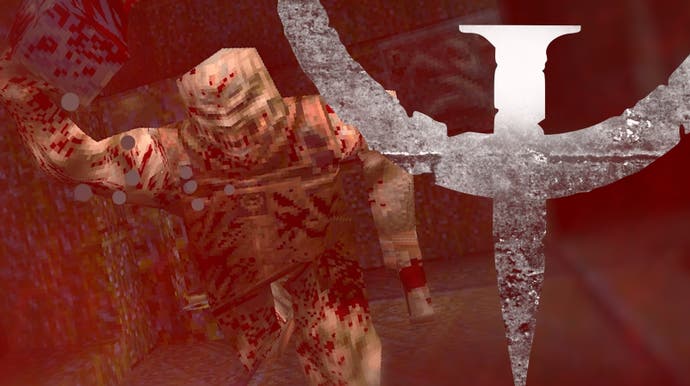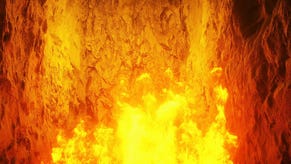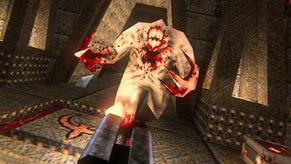Quake revisited: the game, the technology, the ports, the legacy
A fifth anniversary DF Retro special.
Exactly five years ago, Digital Foundry Retro was born! At the time, it was an experiment more than anything else, focusing on just one version of id software's Quake - the astonishing Sega Saturn version, built from scratch by Lobotomy Software. It was the port that John Carmack reckoned couldn't exist, but somehow a talented team found a way. A half-decade on from the release of that video, DF Retro returns to Quake, this time covering it in its entirety: the game, the technology, the ports and the legacy.
Quake itself began as nothing more than a mention in some text blurb in Commander Keen, but even then, there were hints of a game that exceeded the technological limits of the hardware of the time. Building on the mega success of Doom, the first time gamers got to experience Quake was in the release of QTest in early 1996 - a Deathmatch test with three supplied maps. What was obvious was how demanding the game was. Id Software debuted with a software renderer that tapped into the strengths of Intel Pentium processors, running like a slideshow on older 486s and non-Intel processors.
The shareware episode launched in June 1996, with the full game arriving a month later. With its dimly lit corridors, abstract geometry and industrial soundscape, Quake certainly delivered something special. It was a deeply atmospheric, fast paced action game. Quake features vast, complex levels showcasing 3D graphics unlike anything the market had seen before. It builds on the artistic influences which served as a foundation in Doom while introducing dark industrial and Lovecraftian themes. It's chaotic but it works. The technology was phenomenal, but gameplay is king. In the years that followed, games would attempt to push interactive narratives and expand design possibilities but few remain as engaging as Quake.
I detail this in more depth in the video, but I believe the success and longevity of Quake is down to four key pillars: how it pushed the boundaries of technology, the way in which it pioneered the engine licensing model, its modding support and finally the way in which it revolutionised online multiplayer. Looking at that first pillar, Quake was the game that made hardware-accelerated graphics a must-have upgrade for PC gamers, from fascinating beginnings with vQuake for the Rendition Verite, to the GLQuake version of the game that opened the title up to competing 3D technologies, including 3DFX, Nvidia and ATI.
Looking at online multiplayer, it was the later launch of Quakeworld that established the fundamentals on which internet gaming works today, specifically with client-side prediction that smoothed out lag, producing a local-like experience. The client could anticipate things like projectile movement, render out your movement in real-time then negotiate with the server to ensure a seamless experience for all players. Before Quakeworld, everything that happened in a multiplayer game only presented to the player once server data was processed by your PC - a frustrating experience when a 56K modem was the fastest connection available to most gamers. Beyond technology, id also realised the importance of online communities - hence the inclusion of clan support.
And as to why Quake is so long-lived, you can argue that's down to John Carmack's dedication to releasing id games as open source. Since the game's source was released in late 1999, Quake has received countless source ports - some aim to deliver a tried and true Quake experience with quality of life improvements and expanded options, while others focus on pushing visual boundaries. This has allowed creators to build and release so much unique content over the years to the point where Quake and Quake-adjacent work is still being done to this day.
So, what's the best way to play Quake today? If you own a modern PC, check out one of the many source ports. Some of my favorites include Mark V, Quakespasm and Darkplaces - each offers something unique that allows you to expand the Quake experience on modern machines. I've played a lot of great maps over the years as well but one of the best remains Arcane Dimensions - a massive community undertaking featuring some of the finest Quake map design and techniques you'll see. It's an absolute beast of a pack that must be experienced. Releases like In the Shadows also demonstrate how Quake can be used to create something entirely different as well. Finally, I'd say that Quake 1.5 is another interesting mod that aims to enhance the original experience in a multitude of ways. At the core of all of it is the same brilliant gameplay that is still rich and rewarding to this day - and maybe it's time for Bethesda to bring Quake back to prominence.
This article covers just a tiny proportion of the content in the DF Retro video released publicly today (which also covers the console ports) but despite the long run-time, I still feel as if there is much left unsaid. Quake is one of those topics that could be discussed for years to come. So if you want to learn more about the game, firstly, I'd recommend checking out Graphics Programming Black Book from Michael Abrash which includes a lot of information relevant to building games in the 90s. I also urge you to check out Fabien Sanglard's fantastic website which goes into great technical detail on many Quake-based topics. Beyond this, if you're simply looking for more Quake maps, check out Quaddicted - a vast repository of Quake goodness.
In terms of DF Retro itself, this was the first full episode produced in some time, made possible by an incredible level of backing via the Digital Foundry Supporter Program, which gives us the resources we need to make these episodes everything we want them to be: fully researched, with just about every version tested and captured to exacting quality levels and executed with the best possible production values. Supporter Program backers got access to the Quake video a month ago and it goes public today, while backers receive the next full episode - a two hour, 45 minute in-depth analysis of the launch of PlayStation 1, covering every game from every launch territory. It's our most ambitious project yet, so please consider supporting us and joining the wonderful Digital Foundry community.



















